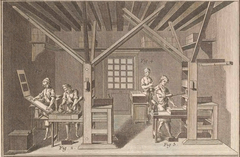Printed Music and Early Printed Books
Thursday, October 15, 2020

We are excited to be included in the list of catalogs on the website Early Printed Books by Sarah Werner, a resource for exploring the history of the medium between 1450 to 1800. The website complements the book Studying Early Printed Books 1450–1800: A Practical Guide (Wiley, 2019) and offers a host of images, videos, and other tools to learn about this period of book history.
The catalogs on this list offer different approaches to searching for information about books in this period of European cultural history, and includes standards such as the Universal Short Title Catalogue (USTC) and the Gesamtkatalog der Wiegendrucke (GW), but also regional catalogs like the Short-title Catalogue, Netherlands (STCN). Though these short-title catalogs do not systematically include printed music (or offer music-specific descriptions to the extent RISM does), they can be valuable to musicologists when considering the production of music books within the broader context of book production and print culture. Since music was often only a small portion of printers’ output in the early decades of printing, exploring other titles by the same printer can open up new avenues of research. For example, compare the 12 music editions from Christian Egenolff in RISM with his 700 books in the USTC.
It is also interesting to view music books from the bibliographic perspective of books in general rather than music specifically. A RISM record for a music edition (such as Luca Marenzio’s Il sesto libro de madrigali, RISM ID no. 990039264) keeps all partbooks together, reflecting how the books were bought, collected, and used at the time. The USTC, in contrast, treats different partbooks as separate publications, meaning that a soprano partbook is described in a different record than the tenor partbook of the same edition. This approach entirely makes sense if you look at the books as individual bibliographic units. After all, those of us who spend time with early printed music know the degree of variation on the title pages within a music edition. And sometimes partbooks were even published in different years, such as Alessandro Grandi’s Messa et salmi (A, T, B: 1635; S, org: 1636; rip.: 1647; RISM ID no. 990022538).
The RISM catalog currently contains over 111,000 records for printed music editions, most of which were published before the year 1800. In our ongoing project to revise and update these records, short-title catalogs belong to our go-to resources, particularly if it is difficult to find a digitized copy of the edition in question. Especially useful for us are the German union catalogs for the 16th, 17th, and 18th centuries, and you’ll see the abbreviations for VD16, VD17, and VD18 throughout RISM.
The records for printed music in RISM live alongside those for music manuscripts, treatises, and libretti, but they can be easily filtered by source type (Print) and searched using fields such as publisher and plate number. We link to digitized copies when we can. The RISM catalog is the most comprehensive catalog of pre-1800 printed music available, and together with other union catalogs it can further our understanding of the printed page.
Image: An illustration of printers from Jean D’Alembert, Robert Bénard, Denis Diderot, Recueil de planches, sur les sciences, les arts libéraux, et les arts méchaniques. [Encyclopédie.] Paris: André le Breton et al, 1769. (vol. 7, plate 14). Smithsonian Libraries, AE25 .E53X 1751 Plates (public domain), via Sarah Werner, Early Printed Books (cropped).
Share Tweet Email
Catégorie: Nouveau au RISM

